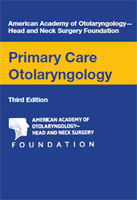Primary Care Otolaryngology is a free downloadable publication by the American Academy of Otolaryngology-Head and Neck Surgery. You can get it here. The original version of the book was written by J. Gregory Staffel, MD more than fifteen years ago and was most recently updated in 2011. It was written primarily for medical students, but it would serve as an excellent refresher for residents and attendings as well.
The book is sharp, short, and to the point. It is only 139 pages long and can be read in only a couple of hours. Topics include ENT emergencies, dizziness, hearing loss, nasal obstruction, thyroid cancer and sinus radiology, among others. Epistaxis, for example, is covered in only about a page and a half. The text addresses the various causes of epistaxis which, of course, include “digital trauma” (i.e., nose-picking), cocaine abuse and coagulopathies. The treatment options are presented in a clear and straightforward manner as well. These include external pressure, alpha agonists, nasal packing and balloon tamponade.

Similarly, instructions for performing an emergency surgical airway are extremely straightforward:
“A good rule of thumb about a tracheotomy is: If you think about performing one, you probably should. It is easier to revise a scar on the neck than to bring the dead back to life…. Please remember the airway is best found in the neck by palpation, not inspection. Take a moment and palpate your own cricothyroid membrane, immediately below your thyroid cartilage. To do an emergency cricothyrotomy you need only a knife. Feel the space, cut down and stick your finger in the hole, feel, and cut again, and again until you are in the airway. Do not worry about bleeding. Place an endotracheal tube in the hole (again, by feel). Be sure not to push it past the carina. By this time, you will be shaking like a leaf—it is okay to let someone else squeeze the bag. Pressure with a dressing will address most bleeding. Occasionally, you might need to use some sutures to stop the bleeding.”
(Page 21)
This, to me, is a nearly perfect tutorial because it prepares the reader from both a technical and an emotional standpoint: this is going to be a bloody mess and you are going to be terrified. So just expect that and don’t waste any time: grab a number whatever blade and make a hole so air can get from Point A to Point B as quickly as possible.
It’s a great little book.


Leave a Reply